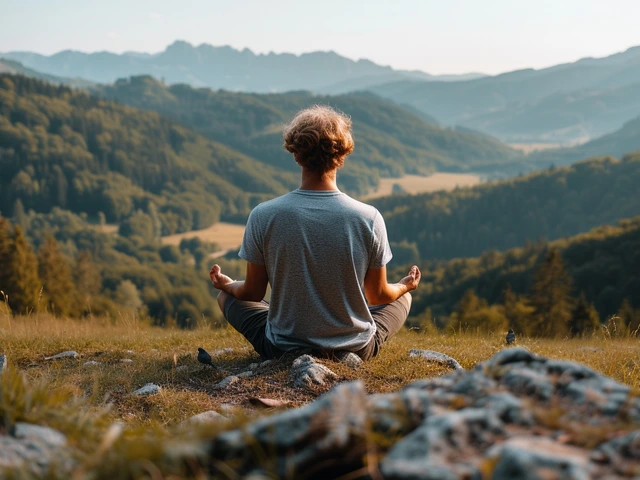If you’ve tried the teas, the blackout curtains, the doom scroll ban, and you still stare at the ceiling, you’re not broken. Insomnia is stubborn because it’s not just about sleep-it’s about arousal. Your brain stays on guard. Meditation lowers that guard. Not a magic off switch, but a reliable dimmer. The goal here: fall asleep faster, wake less, and feel more rested, using short, doable practices that fit a real life-kids, deadlines, noisy neighbors and all.
- TL;DR: Meditation slows the brain’s threat system and steadies breathing, which makes sleep more likely. Expect progress in 2-4 weeks, not overnight.
- Best starter moves: body scan, paced breathing (6 breaths/min), and yoga nidra/NSDR as a safety net for rough nights.
- Evidence: Mindfulness-based programs improve sleep scores and reduce insomnia symptoms in multiple trials (e.g., JAMA Internal Medicine 2015; Sleep Medicine Reviews 2022).
- Use a 10-20 minute practice before bed; add 5 minutes at wake time. Keep caffeine/screen rules to support the gains.
- If you have chronic insomnia or trauma, pair meditation with CBT‑I or a clinician’s guidance; meditation is an adjunct, not a cure-all.
Why Meditation Works for Insomnia (Science You Can Use)
Insomnia hangs around because the brain’s alarm stays switched on. Meditation lowers that alarm by nudging three systems:
- Autonomic balance: Slow, steady breathing and attention training shift the body toward parasympathetic (rest‑and‑digest) mode. Heart rate drops; muscles unclench. That’s the biological doorway to sleep.
- Attention drift: When you train your focus on breath or body, you unhook from worry spirals. Less rumination → less cortisol → easier sleep onset.
- Conditioning: Practicing the same calm routine in bed retrains your brain: bed = sleepy, not fight‑or‑scroll.
What does the research say? A randomized trial in JAMA Internal Medicine (2015, older adults with moderate sleep troubles) found mindfulness training improved PSQI sleep quality scores by about 2.8 points versus 1.1 for a sleep‑education control. A 2022 review in Sleep Medicine Reviews reported small‑to‑moderate improvements in insomnia severity and sleep quality across mindfulness‑based programs. The National Center for Complementary and Integrative Health’s 2024 update notes consistent benefits for subjective sleep quality. The American Academy of Sleep Medicine (2021 guidance) still puts CBT‑I as first‑line for chronic insomnia, but meditation is a helpful add‑on-especially for arousal and rumination.
Bottom line: meditation won’t knock you out like a pill. It reduces the friction that keeps you awake. That friction-racing thoughts, tight chest, fear of not sleeping-is beatable with short, repeatable practice.
A Simple Night Routine: 3 Meditations That Actually Put You to Sleep
Keep this simple. Pick one core practice for bedtime, a quick reset for mid‑night wakeups, and a morning primer. Here’s the kit I use at home while negotiating night water breaks with Harlow and surprise Lego foot traps from Lennox.
Your core bedtime practice (10-20 minutes): Body Scan + Paced Breathing
- Set the scene: dim lights an hour before bed; screens off 30-60 minutes (blue‑light filters help but don’t fix engagement).
- Position: lie on your back, knees supported by a pillow; or on your side if that’s more natural.
- Paced breathing at 6 breaths/min: inhale 4 seconds, exhale 6 seconds. Do 10 cycles. If counting makes you tense, follow your breath with a word like “soft” on the exhale.
- Body scan (head to toes): place attention on one area for 5-10 seconds, notice tingles/pressure/warmth, then release. Move forehead → jaw → neck → shoulders → arms → chest → belly → hips → thighs → calves → feet. No forcing relaxation-just noticing lets muscles drop.
- Drift protocol: if you get sleepy, stop scanning and let attention blur. Sleep is allowed to interrupt practice. That’s a win.
Mid‑night rescue (5-10 minutes): 4‑7‑8 or Box Breathing
- 4‑7‑8: inhale 4, hold 7, exhale 8. Do 4 rounds. The longer exhale taps the vagus nerve and turns down arousal. If breath holds feel edgy, skip the hold and simply extend the exhale.
- Box breathing: inhale 4, hold 4, exhale 4, hold 4, repeat 1-3 minutes. Good when thoughts feel jumpy and you want a steady rhythm.
Pair either with a mini body scan of just jaw, shoulders, and belly-three hot spots for tension.
When your brain won’t shut up: Yoga Nidra/NSDR (20-30 minutes)
Yoga nidra (also called non‑sleep deep rest, NSDR) is a guided practice where you lie down and follow verbal cues through breath, body awareness, and imagery. Think of it as a “sleep‑adjacent” state. Even if you don’t sleep, you’ll lower physical arousal and refill some energy. Many people drift off mid‑track. If I’ve had a spike‑of‑stress day, a nidra track is my parachute.
Script you can use tonight (5‑minute quick start)
- Eyes closed. Inhale through the nose for 4, exhale through the mouth for 6. Three times.
- Place a hand on your chest, one on your belly. Whisper: “Nothing to fix.”
- Notice the touch of the sheets on your calves. The weight of your head. The space inside your mouth. Micro‑soften your tongue.
- Count 10 slow exhales. If you lose count, restart at 1. If you reach 10, restart at 1. The loop is the point.
- Let the breath breathe itself. If sleep comes, let it take you.
Timing rules of thumb
- Do your core practice nightly for 14 days before judging results. Consistency beats intensity.
- If you wake during the night, do a 2-5 minute breathing reset in bed. If you’re still awake after ~20 minutes, get up-dim light, repeat 5 minutes of breathing or nidra, and return to bed when sleepy. That prevents your brain from pairing “bed” with “struggle.”
| Meditation type | Primary effect | Best for | Duration | Evidence snapshot |
|---|---|---|---|---|
| Body scan | Releases muscle tension; anchors attention in the body | Racing thoughts; physical restlessness | 10-20 min | Included in MBSR; improved PSQI in older adults (JAMA IM, 2015) |
| Paced breathing (6 breaths/min) | Shifts autonomic balance; lowers heart rate | Stress spikes; mid‑night wakeups | 2-10 min | Breath pacing reduces sympathetic activity in multiple lab studies |
| 4‑7‑8 / Box breathing | Calms with structured rhythm; extends exhale | Acute anxiety; rumination loops | 1-5 min | Used in clinical and performance settings; supports vagal tone |
| Yoga nidra / NSDR | Deep relaxation; may lead to sleep | High arousal; nap‑replacement on bad nights | 20-30 min | Trials show improved subjective sleep and anxiety reduction |
| Mindfulness of breath (seated) | Trains non‑reactivity; reduces cognitive arousal | Daytime practice to support nights | 5-15 min | Meta‑analyses show modest insomnia symptom reductions |

Daytime Tweaks That Supercharge Your Night Meditation
Meditation works better in a body that’s primed for sleep. Four levers matter most. None are perfect. Together, they compound.
Light
- Morning: get 5-15 minutes of outdoor light within an hour of waking. Cloudy counts. It anchors your body clock and makes melatonin show up on time at night.
- Evening: dim the house an hour before bed. If you must screen, drop brightness, use night shift, and keep the device below eye level. Better: audio only (podcast, audiobook, or a guided practice).
Stimulants and timing
- Caffeine: stop 8-10 hours before bed. If you’re sensitive, make that noon. Decaf still has some caffeine-watch how you feel.
- Alcohol: it might knock you out, but it fragments sleep. If you drink, finish at least 3-4 hours before bed and hydrate.
Movement and temperature
- Daily movement-walks count-lowers baseline arousal. Aim for 20-30 minutes. If intense workouts rev you up at night, move them earlier.
- Warm shower or bath 1-2 hours before bed helps your core temp fall after, which invites sleepiness.
Worry off‑ramp
- Schedule a 10‑minute “brain dump” before dinner. Write the looped worries and one next action for each. Close the notebook. This makes bedtime meditation cleaner because you’ve unloaded the mental tabs.
People ask if gadgets help. A low‑volume white noise machine can mask bumps and barking dogs. Wearables are fine if they don’t make you obsess. If you see a bad score, treat it as a nudge to do your practice-not a verdict on your day.
Troubleshooting: Racing Thoughts, 3 a.m. Wakeups, and Busy Brains
Meditation isn’t always peaceful. If you hit snags, use these fixes.
“I can’t quiet my mind.”
- Don’t aim for “no thoughts.” Aim for “notice and return.” Use a brief anchor: exhale count or the feeling in your palms. Return a hundred times if needed-that’s the rep that changes your brain.
- Try a heavier anchor: squeeze a stress ball during breathing, or place a folded blanket over your belly to feel the breath move.
“Meditation makes me edgy.”
- Switch to eyes‑open, dim‑light breathing while sitting up. Lying down can feel vulnerable for some people.
- Reduce duration to 3 minutes. Focus on extending the exhale; skip long breath holds.
- If trauma is in the mix, work with a trauma‑informed therapist and avoid body scans until you feel safe. Ground with sounds or touch instead.
“I fall asleep during practice-am I doing it wrong?”
- Not wrong. Sleep during a bedtime practice is the point. If it happens during daytime sessions, sit up or shorten the practice.
“I wake at 3 a.m. and can’t get back.”
- Stay in bed for a 2-5 minute exhale‑heavy breathing set. If still alert after ~20 minutes, get up to a dim, boring spot. Do 5-10 minutes of nidra audio or slow breathing, then return when sleepy.
- Check late‑day caffeine, evening alcohol, bedroom temperature (aim 60-67°F/16-19°C). Tiny tweaks here often fix the 3 a.m. wall.
“I meditate and still feel tired.”
- Give it 2-4 weeks. If sleep is still short or unrefreshing, talk to a clinician. Rule out sleep apnea (snoring, gasping), restless legs, thyroid issues, perimenopause changes, or medication effects. Meditation helps arousal but won’t fix a blocked airway.
When to add CBT‑I or medical help
- Insomnia 3+ nights/week for 3+ months, with daytime impact? CBT‑I is the gold standard. Meditation pairs well with it and makes the hard parts easier.
- If you snore loudly, wake choking, or feel sleepy while driving, get a sleep study referral. No meditation should delay that.

Your 14‑Day Plan, Checklist, and Mini‑FAQ
Here’s a short program that fits real life. It’s built to work even if bedtime is chaos and your brain is spicy.
14‑Day plan
- Days 1-3: 10 minutes body scan in bed + 2 minutes paced breathing (4‑in/6‑out). Morning: 3 minutes breath awareness while sitting.
- Days 4-7: 15 minutes body scan + 2 minutes exhale‑lengthening. Add a 5‑minute “worry dump” before dinner. One yoga nidra track if you have a high‑stress day.
- Days 8-10: Choose your favorite: body scan or nidra. Keep 15-20 minutes. Mid‑night: 4 rounds of 4‑7‑8 if you wake.
- Days 11-14: Keep your pick. Add a 10-15 minute daylight walk within an hour of waking. Tighten caffeine cutoff to 10 hours before bed.
What progress looks like
- Week 1: falling asleep a bit faster; less mind‑spiral intensity.
- Week 2: fewer/shorter wakeups; mornings feel a notch better; easier to restart after a rough night.
- By week 4: a new “default” where the bed feels safer and sleep shows up more reliably.
Sleep meditation checklist
- Space: dark, cool, quiet or white noise; phone out of reach or on airplane mode.
- Timing: consistent lights‑down; 10-20 minutes of practice nightly.
- Anchor: breath count, body scan, or nidra-pick one and repeat.
- Reset: 2-5 minute exhale‑heavy breathing after night wakeups.
- Support: morning daylight, caffeine cutoff, worry dump ritual.
- Mindset: the goal is “less fight,” not “perfect sleep.”
Decision help: which practice should I pick?
- If your body feels wired (tight jaw, racing heart): start with paced breathing + body scan.
- If thoughts are sticky and story‑heavy: try guided yoga nidra to give your mind a job.
- If you hate lying still: do 3 minutes of seated breath first, then lie down for 7-10 minutes.
Mini‑FAQ
- How long until it works? Most people notice some relief in 1-2 weeks, with bigger changes by 4 weeks. Keep sessions short and daily.
- Morning or night? Both. 3-5 minutes in the morning smooths the day; 10-20 minutes at night targets sleep.
- Apps or no apps? Use what you’ll stick with-app, timer, or a simple script. If voices annoy you, go silent with a breath count.
- What if I miss a night? No guilt. Do a 3‑minute reset the next day and keep going.
- Can meditation replace sleep? No. Yoga nidra can restore some calm and alertness, but it’s not full sleep. Treat it as a safety net, not a substitute.
Next steps
- Pick one practice tonight and set a 15‑minute timer. Tomorrow morning, grab 5-10 minutes of outdoor light.
- Track three things for 14 days: sleep latency (minutes to fall asleep), number of wakeups, and how you feel at 10 a.m. Watch the trend, not single nights.
- If insomnia has been chronic or severe, ask your clinician about CBT‑I. Meditation plus CBT‑I is a powerful combo.
If you only remember one thing: make your nights boring and repeatable. The brain loves patterns. A short dose of meditation for sleep, the same way, at the same time, tilts the odds in your favor. Mine did, even with Harlow’s “I forgot to tell you about the volcano project” and Lennox’s “I need the blue blanket, not the blue‑blue one.” Your life won’t get quieter. Your nervous system can.





